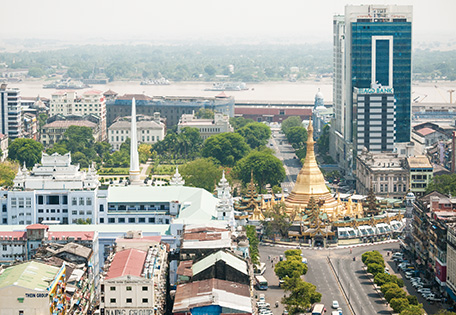Japan's Official Development Assistance White Paper 2013
Section 3 Myanmar: The Future of a Frontier Supported by Public-Private Partnerships
Since the inauguration of the Thein Sein administration in March 2011, the process of democratization, national reconciliation, and economic reforms has been moving along quickly in Myanmar, whose potential has drawn substantial attention. To support Myanmar’s reform efforts, the Japanese government announced in April 2012 that it had reviewed its assistance policy towards Myanmar and that it would resume its extensive assistance. Upon implementing its arrears clearance operation with Myanmar and supporting its return to the international community, the Japanese government in May 2013, for the first time in 26 years, provided three new ODA Loans totaling approximately ¥51.1 billion to the Government of Myanmar.
All three ODA Loans are for infrastructure development. In order to promote development and poverty eradication in the whole country, Myanmar essentially needs assistance not only for large cities such as Yangon, but also for rural areas where many of Myanmar’s poor citizens live (including areas where ethnic minorities live). The goal of “Regional Development Project for Poverty Reduction Phase 1” is to improve the livelihood of residents by constructing and rehabilitating life-supporting infrastructure, such as roads, electricity, and water supply, the inadequacy of which has been hindering the development of rural areas. “Urgent Rehabilitation and Upgrade Project Phase 1” is intended to address the problem of constantly enforced power cuts, which disturb people’s daily lives and economic activities in Yangon. Yangon, where the demand for electricity is the largest in the country, is expected to see further boosts in economic activities. This project will work to solve the power shortage by means of rehabilitating and upgrading existing power facilities.
The third ODA Loan is “Infrastructure Development Project in Thilawa Area Phase 1.” To raise national income through economic growth, the Government of Myanmar places importance on increasing direct investment from overseas. In particular, Myanmar has made it a policy to attract foreign companies by developing its Special Economic Zones (SEZs). Among them, the Thilawa SEZ Development Project being implemented in a neighboring area of Yangon, the largest city in Myanmar, has captured much interest as a large-scale project undertaken jointly by Japan and Myanmar. This project is expected to contribute to the improvement in economic activities and residents’ lives in Thilawa area by developing a terminal at the Port and electric power facilities.
The Thilawa SEZ, located about 20 km southeast of Yangon, is a vast region with a total area spanning 2,400 ha (approximately 40% of Manhattan). The Governments of Japan and Myanmar have affirmed that the two countries would collaborate to develop the Thilawa SEZ, and the public and private sectors of the two countries will make concerted efforts to develop the industrial zones.
In the Thilawa SEZ, preparations are underway to start establishing businesses in a 400 ha area, the section of the SEZ slated for initial development. Some of the resumed ODA Loans described above are to be used for the development of the surrounding infrastructure, namely roads and a port. Furthermore, a consortium established by private companies and other entities in Japan and Myanmar will lead the work of developing the industrial park in the initial development area. Japan is considering investing in this consortium using the JICA Private-Sector Investment Finance scheme which fully resumed in October 2012, and will work to reduce the investment costs and risks shouldered by private companies.
As a project which pools the strengths of the public and private sectors and supports development in cooperation with Myanmar, the Thilawa SEZ Development Project is precisely a model case of infrastructure assistance in developing countries and a project in which the Japanese business community has expressed great interest. This project is expected not only to serve as a foundation for the advance of foreign companies including Japanese companies into Myanmar, but also to play a large role in the sustainable economic development and expansion of stable employment in the country.
The Japanese government will continue to provide to Myanmar assistance for improving people’s lives, including in the areas of agriculture, health, and education which contribute to poverty reduction, assistance for ethnic minorities, and assistance for the capacity development of human resources and institutional development. In the infrastructure sector which promotes economic growth, the Japanese government will further offer balanced cooperation through the close partnership of the public and private sectors, while gauging the needs of Myanmar and continuing to watch over the outcome of its reforms.

A panorama of the old city in Yangon. The temple located at the center of the intersection is Sule Pagoda. (Photo: Mika Tanimoto / JICA)
